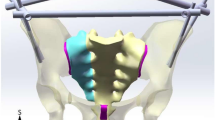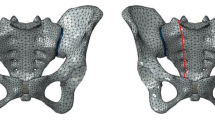Abstract
Purpose of the study
The comparison of the stability of four surgical methods for the treatment of vertically and rotationally unstable type C pelvic ring injuries.
Methods
We produced a type C pelvic ring injury (type Denis II fracture of the sacrum and symphysiolysis) on a finite element model, in the case of standing on both feet. We stabilized the symphysiolysis with a five-hole reconstruction plate; the sacrum fracture was fixed in the first experiment with two, two-hole reconstruction plates on the ventral surface, in the second one we applied dorsally the transsacral, narrow DC plate, in the third one with KFI-H plate, and in the last one with iliosacral screw. Finite element modeling was performed by the use of the ALGOR software. Not only bones and joints, but joints and mechanically important ligaments were modeled as well. We measured the shift between the two surfaces of the fracture gap, compared to the results of measurements accomplished on cadaver models.
Results
Larger shift could be elicited after transsacral plating than after direct plating. These results correspond to those of the parallel investigation of the bony ligamentous cadaver pelvis specimens. The shift values after KFI-H plating and iliosacral screw fixation are larger than after direct plating, but smaller than after transsacral plating. The tension created in the implants is less than the allowed values; therefore, the choice of operation should depend on the type of injury.
Conclusions
The finite element model may be utilized for the comparison of different methods of osteosynthesis for the treatment of injuries described above. Due to several difficulties in investigations performed on cadaver specimens, this model has undoubted utility.





Similar content being viewed by others
References
Abé H, Hayashi K, Sato M (1996) Data Book on Mechanical Properties of Living Cells, Tissues and Organs. Springer Verlag, Tokyo
Binder JB (1995) Algor finite element modeling tools aid aerospace. Aerosp Am 33:16–18
Cziffer E (1997) Operatíve Treatment of the Fractures (in Hungarian). Springer Hungarica, Budapest pp: 417–425
Dalstra M, Huiskes R (1995) Load transfer across the pelvic bone. J Biomech 28:715–724
Hasenfrancz P, Varga E, Váradi K (1998) Finite element modeling of pelvic bone. Mechanical Engineering `98 (in Hungarian). Budapest pp: 115–119
Mears DC, Capito CP, Deleuw H (1988) Posterior pelvic disruptions managed by the use of the Double Cobra Plate. Instr Course Lect 37:143–150
Pohlemann T, Angst M, Schneider E, Ganz R, Tscherne H (1993) Fixation of transforaminal sacrum fractures: a biomechanical study. J Orthop Trauma 2:107–117
Ragnarsson B, Olerud C, Olerud S (1993) Anterior square-plate fixation of sacroiliac disruption. 2–8 years follow up of 23 consecutive cases. Acta Orthop Scand 64(2):138–142
Routt ML Jr, Meir MC, Kregor PK, Mayo KM (1993) Percutaneous iliosacral screws with the patient supine technique. Oper Tech Orthop 3:35–45
Routt ML Jr, Kregor PJ, Simonian PT, Mayo KA (1995) Early results of percutaneous iliosacral screws placed with the patient in the supine position. J Orthop Trauma 3:207–214
Szita J (1992) Experimental and clinical analysis of pelvic ring injuries. Doctoral thesis, Semmelweis University, Budapest (in Hungarian)
Tile M (1988) Pelvic ring fractures: should they be fixed? J of Bone and Jt Surg 70:1–12
Conflict of interest
The authors declare that they have no conflict of interest.
Author information
Authors and Affiliations
Corresponding author
Rights and permissions
About this article
Cite this article
Bodzay, T., Flóris, I. & Váradi, K. Comparison of stability in the operative treatment of pelvic injuries in a finite element model. Arch Orthop Trauma Surg 131, 1427–1433 (2011). https://doi.org/10.1007/s00402-011-1324-3
Received:
Published:
Issue Date:
DOI: https://doi.org/10.1007/s00402-011-1324-3




